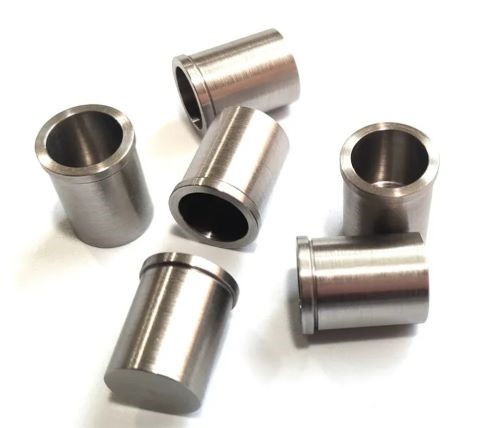Molybdenum Crucibles: Features, Production, and Cleaning
Post Views:
1,673
Introduction
Molybdenum is widely used in various industries such as metallurgy, electronics, and nuclear energy due to its excellent properties such as high melting point, corrosion resistance, and good thermal conductivity. With these impressive characteristics, molybdenum is employed to make crucibles, evaporation boats, and other useful tools. In this article, we’ll focus on molybdenum crucibles, discussing their features, manufacturing, and cleaning methods. Hope that you can have a better comprehension of molybdenum crucibles by the end of this article.

Figure 1. Molybdenum Crucibles
What Are the Features of Molybdenum Crucibles?
Molybdenum crucibles share similar properties with molybdenum.
- Exceptional Thermal Performance: The molybdenum crucible has a high melting point of 2,623 °C (4,753 °F), surpassed only by carbon, tantalum, and tungsten. Yet, tantalum and tungsten are much more expensive and hard to machine. Molybdenum crucibles also stand out for their low coefficient of thermal expansion, and good thermal conductivity, which makes them one of the popular refractory materials.
- Outstanding Chemical Stability: Molybdenum crucibles can withstand numerous non-oxidizing organic acids. Also, they are resistant to many molten metals and glasses, making them ideal for the use of glass melting. So these crucibles could stay stable at room temperature and high temperatures.
- Other Great Features: Molybdenum crucibles are also characterized by great hardness, impressive creep resistance, and good electrical conductivity.
How to Produce Molybdenum Crucibles?
Here are the steps to manufacture molybdenum crucibles:
- Raw material preparation: Molybdenum powder is produced by reducing molybdenum oxide with hydrogen gas. The resulting powder is screened to remove any impurities.
- Powder consolidation: The molybdenum powder is consolidated into a billet by cold isostatic pressing (CIP).
- Sintering: The molybdenum blanks are sintered in a high-temperature furnace, usually around 2000°C, which bonds the molybdenum particles together to form a solid crucible.
- Machining and finishing: The crucible is machined to achieve the desired dimensions and surface finish. This can include processes such as turning, milling, and polishing.
- Quality control: The finished molybdenum crucible is inspected to ensure that it meets the required specifications and quality standards.
As for the third step, other processes such as stamping or welding can also be used. The three types of molybdenum crucibles have their advantages respectively. The stamping crucibles possess relatively lower costs yet come with thinner walls. The welding crucibles have thicker walls and longer service life. In contrast, the sintering kind is the most commonly used.
Please visit our homepage for molybdenum crucibles in the form of oval, tapered, bottomless, or round mouths. Customized molybdenum crucibles are also welcome.
How to Clean Molybdenum Crucibles?
Cleaning molybdenum crucibles appropriately is essential to ensure their long-term durability and efficiency. There are several methods for cleaning molybdenum crucibles, depending on the type of contamination and the degree of cleaning required.
- Acid Cleaning: This method involves immersing the molybdenum crucible in a dilute acid solution, such as hydrochloric acid, for a specific period, then rinsing thoroughly with distilled water. It is effective for removing contaminants such as oxides, grease, and oils. The advantage of this method is that it is relatively quick and easy to perform; however, it can be dangerous because of the acid used in the process.
- Electrolytic Cleaning: You can also use an electrolytic cleaning bath to remove contaminants. The molybdenum crucible is immersed in the cleaning solution, and an electrical current is passed through the bath. This method is a gentle cleaning method that removes severe contaminants from molybdenum crucibles. It will not damage the surface of the crucible, but requires specialized equipment and can be time-consuming.
- Ultrasonic Cleaning: This method means immersing the molybdenum crucible in a cleaning solution and subjecting it to high-frequency ultrasonic waves. The waves create high-pressure bubbles that dislodge contaminants on the surface of the crucible. This method is also gentle method and will not cause damage to the crucible. It is very effective on small particles and contaminants on molybdenum crucible surfaces, but may not be effective on severe contamination.
- Mechanical Cleaning: Mechanical cleaning refers to physically removing heavy contaminants and oxides from the surface of the molybdenum crucible using a wire brush or abrasive pads. This is a relatively simple and inexpensive method, but it can be time-consuming and, if done incorrectly, can damage the crucible surface.
The table below summarizes the characteristics of different molybdenum crucible cleaning approaches. For more information, you can check our website.

Conclusion
Molybdenum crucibles play a critical role in various industries due to their excellent properties. The production process involves raw material preparation, powder consolidation, sintering, machining, and finishing, etc. To ensure the long-term durability and efficiency of your molybdenum crucibles, you can use appropriate cleaning methods, including acid cleaning, electrolytic cleaning, ultrasonic cleaning, and mechanical cleaning.
Advanced Refractory Metals offers a variety of molybdenum crucibles. You can also find other high-quality molybdenum products on our homepage. We also provide low prices and great lead time. Send us an inquiry if you are interested.


